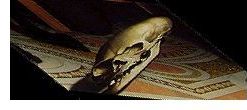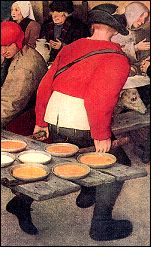
Feature Archive |
| Scandale: The Salons | |
| Revenge: Artimesia Gentileschi | |
| Sittings from Hell: Sargent/Carnation, Lily, Lily, Rose | |
| Private Commissions: Khalil Bey | |
| Rejected Portraits: Kahlo/The Suicide of Dorothy Hale | |
| Villains: Fra Bartolommeo/Savonarola | |
| Surprises: Rembrandt |
Hans Holbein's great double portrait, The Ambassadors, is a kind of Vanitas painting - showcasing the wealth and greatness of two 16th-century Masters of the Universe against the backdrop of the ever-present specter of death. There's a crucifix, a hymnbook and a lute with a broken string mixed in with various symbols of worldly success and of course the stunning richness of the ambassadors' garb.
 It's easy to look at this portrait without registering the most important person present: a huge skull of death in the forefront of the painting. It's distorted so that it's barely recognizable, unless you view the image at a sharp angle (I've reversed the distortion in the image at left).
It's easy to look at this portrait without registering the most important person present: a huge skull of death in the forefront of the painting. It's distorted so that it's barely recognizable, unless you view the image at a sharp angle (I've reversed the distortion in the image at left).Why did Holbein place this dark symbol between the viewer and the subjects? Jean de Dinteville, the ambassador on the left who commissioned the portrait, is said to have suffered from melancholia, and may have requested this theme. Or perhaps Holbein is making his own comment on the ambassador's dark moods.

There's a different kind of surprise awaiting us in Pieter Bruegel's Peasant Wedding. The waiter on the far right looks for all the world to have three feet. (I can imagine his letters home: "Dear Mom: Since moving to Flanders I've grown another foot!")
Postscript: I've since found a copy of this painting made by the artist's son, Pieter Bruegel the Younger. This copy does not show the third foot. Interesting.

Maybe the waiter is related to the three-armed woman in the Rembrandt engraving of a couple making love, Ledikant (Le Lit à la Française). She clearly has an extra left arm.
There's an interesting story about another of Rembrandt's works: Arnold Houbraken records that Rembrandt was commissioned to paint a large portrait of a couple and their children. Rembrandt had a monkey he kept as a pet, and during the course of painting the family, the monkey happened to die.
Rembrandt's tribute to his beloved pet was to paint the dead monkey into the family portrait. When he saw the painting, the father was appalled at the presence of the corpse and demanded that it be removed. Rembrandt refused, telling him to take it or leave it. He left it, and Rembrandt ended up with the painting. The portrait seems to have since been lost (or else the monkey was eventually painted out after all).
 Finally, what is that upside-down face doing on the Madonna's knee in yet another work by Rembrandt, Madonna and Child in the Clouds? (It looks spookily like the Face on Mars.) We know it can't be a miraculous appearance of the face of Jesus or the Virgin Mary, because they're both already in the picture - right side up.
Finally, what is that upside-down face doing on the Madonna's knee in yet another work by Rembrandt, Madonna and Child in the Clouds? (It looks spookily like the Face on Mars.) We know it can't be a miraculous appearance of the face of Jesus or the Virgin Mary, because they're both already in the picture - right side up.Come back in November to read the conclusion to this article. Overly flattering portraits! Heretical portraits! Male nudes! Female nudes! Grotesques, horrors and freaks! Exclamation points! Corrections to this month's article! And much much much much more!
Have we missed anything important? Know of a favorite portrait that qualifies as "notorious" for some reason? Let me know.
This article is copyright 2000 by John Malyon. Please do not republish any portion of this article without written permission.
John Malyon can be contacted at jmalyon@artcyclopedia.com